Physical Address
304 North Cardinal St.
Dorchester Center, MA 02124
anorectal plugs
cystic fibrosis
Gastrografin enema
meconium ileus
meconium peritonitis
meconium plugs
Meconium consists of bile salts, bile acids, and debris shed from the intestinal mucosa in the intrauterine period. More than 90% of full-term newborn infants and 80% of very-low-birthweight (VLBW) infants pass meconium within the 1st 24 hr. The possibility of intestinal obstruction should be considered in any infant who does not pass meconium by 24-36 hr.
Meconium plugs syndrome refers to intestinal obstruction, usually in the distal colon, rectum, and anal canal, caused by meconium plugs ( Fig. 123.1 ). Resulting from a disproportionately low amount of water in the intestinal lumen, meconium plugs are a rare cause of intrauterine intestinal obstruction and meconium peritonitis unrelated to cystic fibrosis (CF). Anorectal plugs may also cause mucosal ulceration from bowel wall erosion and subsequent intestinal perforation. Meconium plugs are associated with small left colon syndrome in infants of diabetic mothers, CF (40%), Hirschsprung disease (40%), maternal opiate use, magnesium sulfate therapy for preeclampsia, and tocolysis. Up to 30% of patients can have spontaneous resolution. Initial treatment may include administration of a glycerin suppository or rectal irrigation with isotonic saline. In up to 95% of patients, a Gastrografin enema (meglumine diatrizoate, a hyperosmolar, water-soluble, radiopaque solution containing 0.1% polysorbate 80 [Tween 80] and 37% organically bound iodine) will be both diagnostic and therapeutic, inducing passage of the plug, presumably because the high osmolarity (1,900 mOsm/L) of the solution draws fluid rapidly into the intestinal lumen and loosens the inspissated material. Such rapid loss of fluid into the bowel may result in acute fluid shifts with dehydration and shock, so it is advisable to dilute the contrast material with an equal amount of water and provide intravenous (IV) fluids, during and for several hours after the procedure, sufficient to maintain normal vital signs, urine output, and electrolytes. After removal of a meconium plug, the infant should be observed closely and consideration given to performing diagnostic testing to identify Hirschsprung disease (congenital aganglionic megacolon; see Chapter 358.4 ) and CF (see Chapter 432 ).
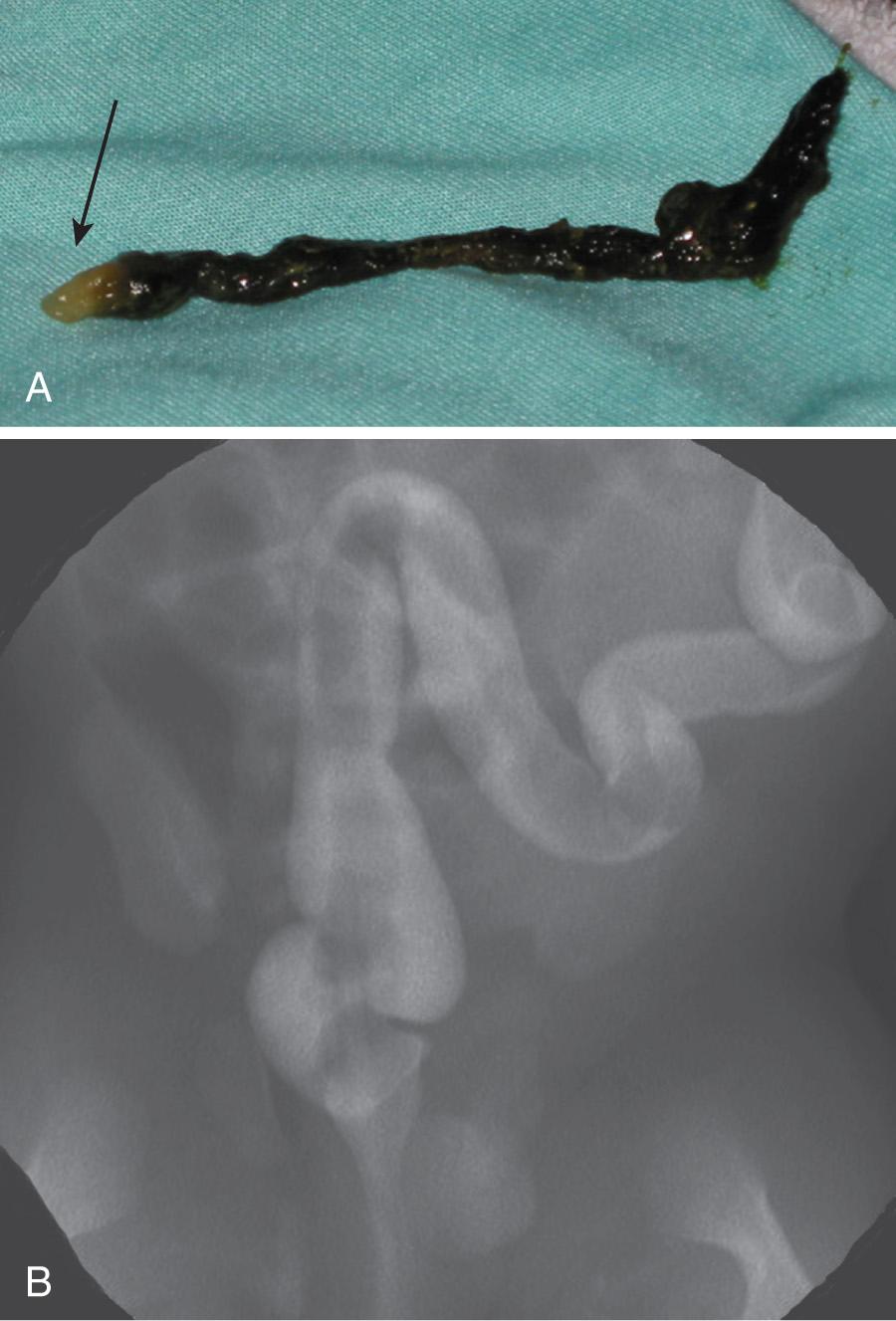
Meconium ileus, or impaction of inspissated meconium in the distal small bowel, accounts for up to 30% of cases of neonatal intestinal obstruction. It is common in patients with CF in whom the lack of fetal pancreatic enzymes inhibits digestive mechanisms, and meconium becomes viscid and mucilaginous. Clinically, neonates present with intestinal obstruction with or without perforation. Abdominal distention is prominent, and vomiting, often bilious, becomes persistent, although occasionally inspissated meconium stools may be passed shortly after birth. Meconium ileus can present as early as in utero, in which the fetus develops acute intestinal obstruction resulting in volvulus or perforation, peritoneal ascites, meconium peritonitis, and hydrops; if untreated, fetal loss may occur.
Meconium ileus is primarily associated with cystic fibrosis transmembrane regulator (CFTR) mutations F508del, G542X, W1282X, R553X, and G551D. Patients with two copies of the F508del mutation have a 25% chance of presenting with meconium ileus. F508del plus any other CF mutation confers 17% risk, and two other CF mutations confer a 12% risk of meconium ileus. In addition, non-CFTR genetic modifier genes influence meconium ileus. In families who already have at least one child with CF complicated by meconium ileus, there is a 39% risk for meconium ileus in subsequent children, which is more than the rates expected with autosomal recessive inheritance. In a twin study, 82% of monozygotic twins showed concordance for meconium ileus, whereas only 22% of dizygotic and 24% of two affected siblings showed concordance. Positive newborn screening for CF should prompt sweat testing when the infant weighs >2 kg and is at least 36 wk of corrected gestational age. Genetic testing confirms the diagnosis of CF (see Chapter 432 ).
The differential diagnosis involves other causes of intestinal obstruction, including intestinal pseudoobstruction, and other causes of pancreatic insufficiency (see Chapter 377 ). Prenatal diagnosis is readily achieved by ultrasound with identification of enlarged bowel loops or a mass with distention of the proximal small bowel. Clinically the diagnosis can be made with a history of CF in a sibling, by palpation of doughy or cordlike masses of intestines through the abdominal wall, and from the radiographic appearance. Plain radiographs reveal small bowel obstruction. Air-fluid levels may not be apparent because of the thickened meconium.
In contrast to the generally evenly distended intestinal loops above an atresia, the loops may vary in width and are not as evenly filled with gas. At points of heaviest meconium concentration, the infiltrated gas may create a bubbly, granular appearance ( Figs. 123.2 and 123.3 ).
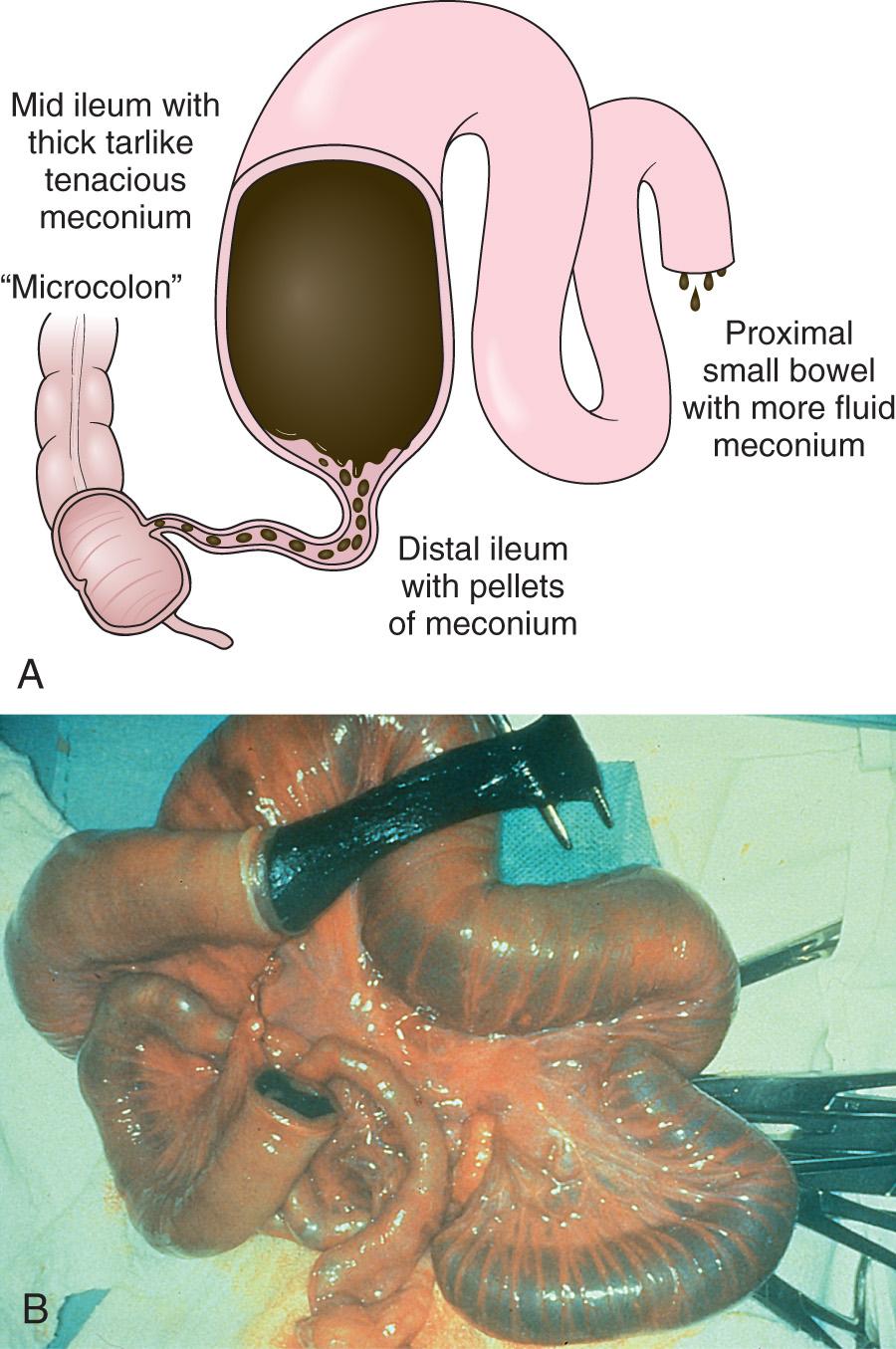
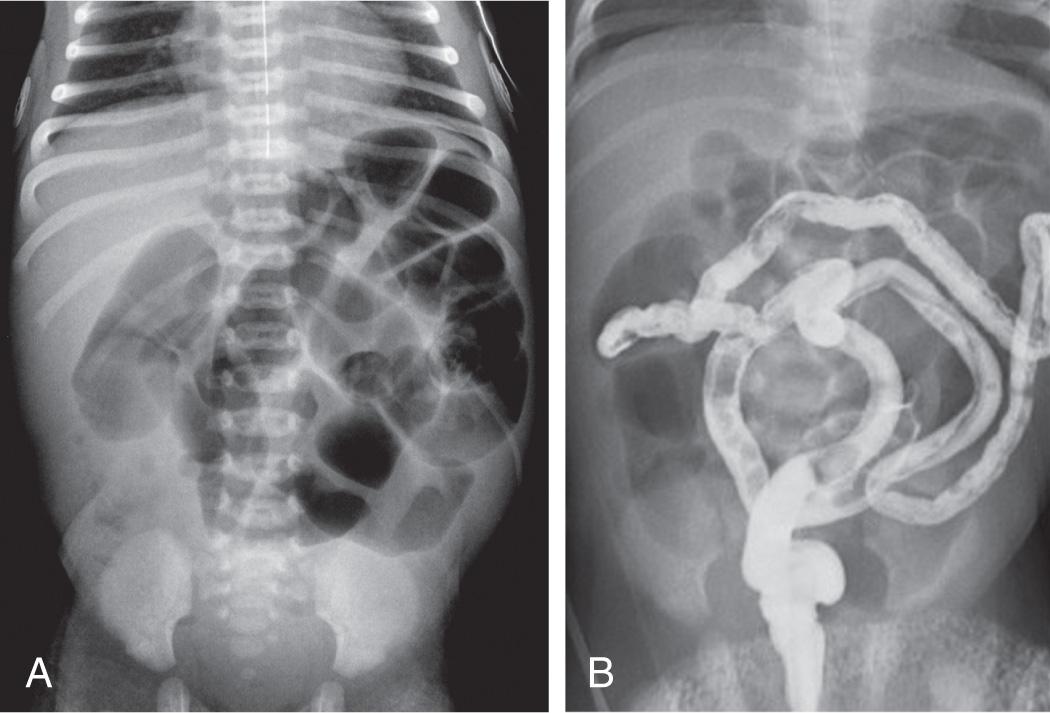
Treatment for simple meconium ileus is a high-osmolarity Gastrografin enema, as described for meconium plugs. If the procedure is unsuccessful or perforation of the bowel wall is suspected, a laparotomy is performed and the ileum opened at the point of largest diameter of the impaction. Approximately 50% of these infants have associated intestinal atresia, stenosis, or volvulus that requires surgery. The inspissated meconium is removed by gentle and patient irrigation with warm isotonic sodium chloride or N -acetylcysteine (Mucomyst) solution through a catheter passed between the impaction and the bowel wall. Some patients will require bowel resection with a temporary double-barrel enterostomy followed by serial irrigations and distal refeeding, or primary anastomosis at the initial operation. Most infants with meconium ileus survive the neonatal period. If meconium ileus is associated with CF, the long-term prognosis depends on the severity of the underlying disease (see Chapter 432 ).
Perforation of the intestine may occur in utero or shortly after birth. Frequently, the intestinal perforation seals naturally with relatively little meconium leakage into the peritoneal cavity. Perforations occur most often as a complication of meconium ileus in infants with CF but occasionally result from a meconium plug or in utero intestinal obstruction of another cause.
Cases at the most severe end of the spectrum may be diagnosed on prenatal ultrasound with fetal ascites, polyhydramnios, bowel dilation, intraabdominal calcifications, and hydrops fetalis ( Fig. 123.4 ). At the other end are cases in which an intestinal perforation may seal spontaneously and patients remain asymptomatic, except when meconium becomes calcified and is later discovered on radiographs. Alternatively, the clinical picture may be dominated by signs of intestinal obstruction (as in meconium ileus) with abdominal distention, vomiting, and absence of stools or chemical peritonitis presenting with sepsis. Treatment consists primarily of elimination of the intestinal obstruction and drainage of the peritoneal cavity with a timely surgical intervention proved to result in high survival rate and favorable outcome even in complicated meconium peritonitis.

biomarkers
necrotizing enterocolitis
NEC
pneumatosis intestinalis
primary peritoneal drainage
PPD
probiotics
Necrotizing enterocolitis (NEC) is the most common life-threatening emergency of the gastrointestinal (GI) tract in the newborn period. The disease is characterized by various degrees of mucosal or transmural necrosis of the intestine. The cause of NEC remains unclear but is most likely multifactorial. The incidence of NEC is 5–10% among infants with birthweight <1500 g, with mortality rates of 20–30% and approaching 50% in infants who require surgery. Both incidence and case fatality rates increase with decreasing birthweight and gestational age.
Many factors contribute to the development of the pathologic findings of NEC, including mucosal ischemia and subsequent necrosis, gas accumulation in the submucosa of the bowel wall (pneumatosis intestinalis), and progression of the necrosis to perforation, peritonitis, sepsis, and death. The distal part of the ileum and the proximal segment of colon are involved most frequently; in fatal cases, gangrene may extend from the stomach to the rectum (NEC totalis). The pathogenesis of NEC remains to be completely elucidated, but 3 major risk factors have been implicated: prematurity, bacterial colonization of the gut, and formula feeding. NEC develops primarily in premature infants with exposure to metabolic substrate in the context of immature intestinal immunity, microbial dysbiosis, and mucosal ischemia. An underlying genetic predisposition is being recognized with variants in genes regulating immunomodulation and inflammation (e.g., Toll-like receptor-4, IL-6), apoptosis and cellular repair (e.g., platelet-activating factor), and oxidant stress (e.g., vascular endothelial growth factor, arginine, nitric oxide). The greatest risk factor for NEC is prematurity. NEC rarely occurs before the initiation of enteral feeding and is much less common in infants fed human milk. Aggressive enteral feeding may predispose to the development of NEC.
Although nearly 90% of all cases of NEC occur in preterm infants, the disease can occur in full-term neonates. NEC in term infants is often a secondary disease, seen more frequently in infants with history of birth asphyxia, Down syndrome, congenital heart disease, rotavirus infections, gastroschisis, and Hirschsprung disease.
Infants with NEC have a variety of signs and symptoms and may have an insidious or sudden catastrophic onset ( Table 123.1 ). The onset of NEC is usually in the 2nd or 3rd week of life but can be as late as 3 mo in VLBW infants. Age of onset is inversely related to gestational age. The first signs of impending disease may be nonspecific, including lethargy and temperature instability, or related to GI pathology, such as abdominal distention, feeding intolerance, and bloody stools. Because of nonspecific signs, sepsis may be suspected before NEC. The spectrum of illness is broad, ranging from mild disease with only guaiac-positive stools to severe illness with bowel perforation, peritonitis, systemic inflammatory response syndrome, shock, and death. Laboratory derangements may include neutropenia, anemia, thrombocytopenia, coagulopathy, and metabolic acidosis. Hypotension and respiratory failure are common. Progression may be rapid, but it is unusual for the disease to progress from mild to severe after 72 hr.
| GASTROINTESTINAL |
|
| SYSTEMIC |
|
A very high index of suspicion in treating preterm at-risk infants is crucial. Plain abdominal radiographs are essential to make a diagnosis of NEC. The finding of pneumatosis intestinalis (air in the bowel wall) confirms the clinical suspicion of NEC and is diagnostic; 50–75% of patients have pneumatosis when treatment is started ( Fig. 123.5 ). Portal venous gas is a sign of severe disease, and pneumoperitoneum indicates a perforation ( Figs. 123.6 and 123.7 ). Ultrasound with Doppler flow assessment may be useful to evaluate for free fluid, abscess, and bowel wall thickness, peristalsis, and perfusion.
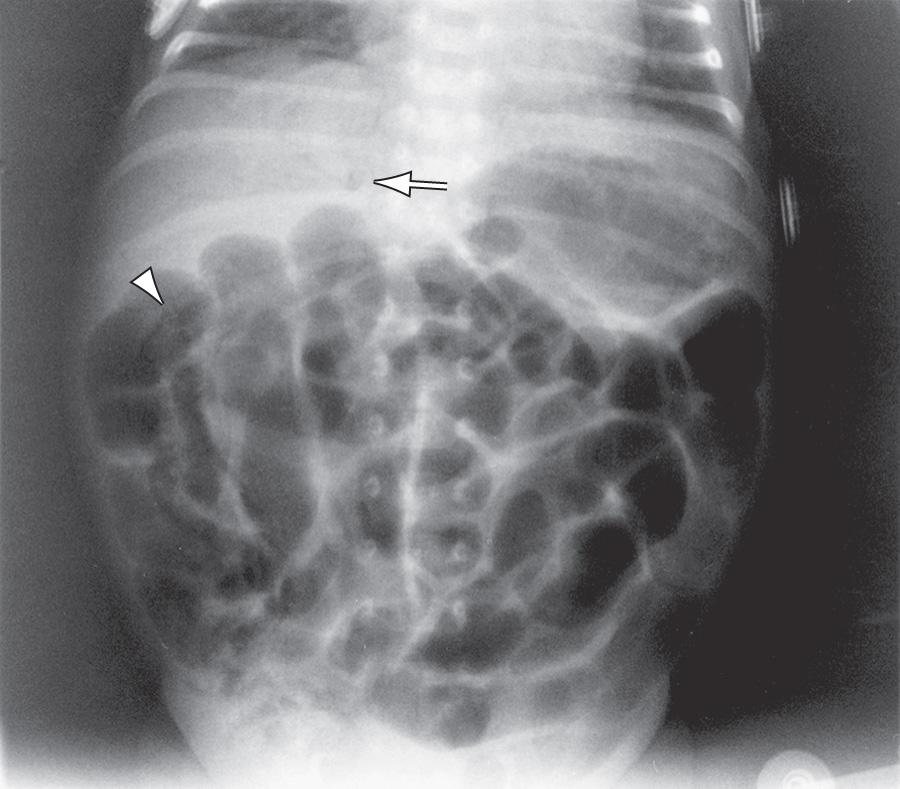

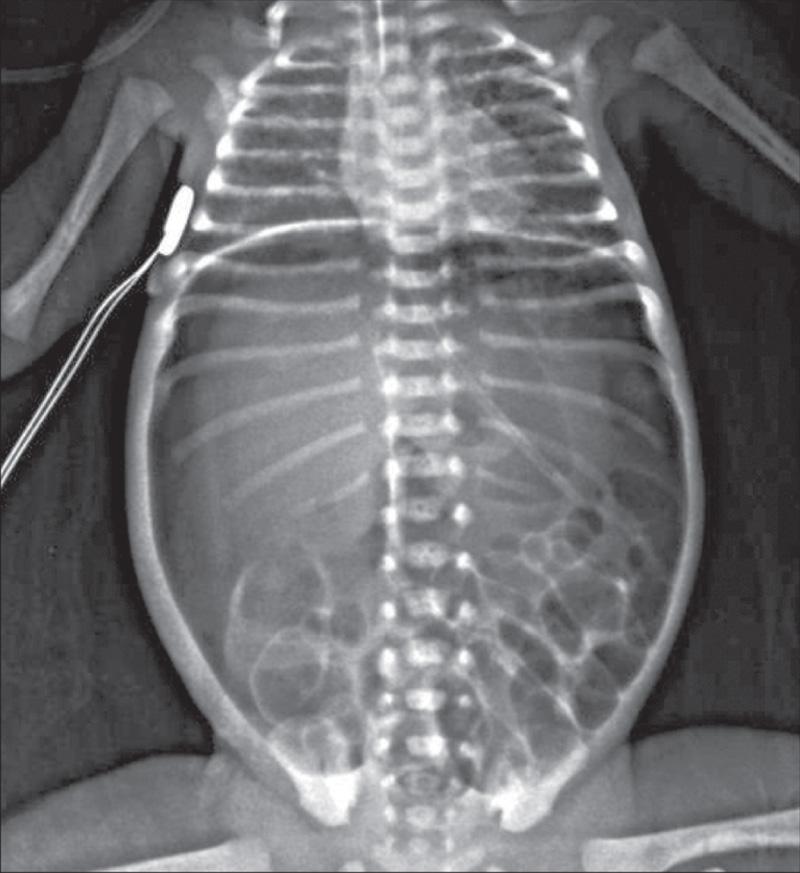
The differential diagnosis of NEC includes specific infections (systemic or intestinal), GI obstruction, volvulus, and isolated intestinal perforation. Idiopathic focal intestinal perforation can occur spontaneously or after the early use of postnatal corticosteroids and indomethacin. Pneumoperitoneum develops in such patients, but they are usually less ill than those with NEC.
Rapid initiation of therapy is required for infants with suspected as well as proven NEC. There is no definitive treatment for established NEC, so therapy is directed at providing supportive care and preventing further injury with cessation of feeding, nasogastric decompression, and administration of IV fluids. Careful attention to respiratory status, coagulation profile, and acid-base and electrolyte balances are important. Once blood has been drawn for culture, systemic antibiotics (with broad coverage based on the antibiotic sensitivity patterns of the gram-positive, gram-negative, and anaerobic organisms in the particular neonatal ICU) should be started immediately. If present, umbilical catheters should be removed, but good IV access needs to be maintained. Ventilation should be assisted in the presence of apnea or if abdominal distention is contributing to hypoxia and hypercapnia. Intravascular volume replacement with crystalloid or blood products, cardiovascular support with fluid boluses and/or inotropes, and correction of hematologic, metabolic, and electrolyte abnormalities are essential to stabilize the infant with NEC.
The patient's course should be monitored closely by means of frequent physical assessments; sequential anteroposterior and cross-table lateral or lateral decubitus abdominal radiographs to detect intestinal perforation; and serial determinations of hematologic, electrolyte, and acid-base status. Gown and glove isolation and grouping of infants at similar increased risks into cohorts separate from other infants should be instituted to contain an epidemic.
A surgeon should be consulted early in the course of treatment. The only absolute indication for surgery is evidence of perforation on abdominal radiograph (pneumoperitoneum) present in less than half of infants with perforation or necrosis at operative exploration. Progressive clinical deterioration despite maximum medical management, a single fixed bowel loop on serial radiographs, and abdominal wall erythema are relative indications for exploratory laparotomy. Ideally, surgery should be performed after intestinal necrosis develops but before perforation and peritonitis occur. The optimal surgical approach, however, remains controversial. The options for surgical treatment include primary peritoneal drainage (PPD) or exploratory laparotomy with resection of the necrotic intestine and usually stoma creation. Two randomized clinical trials in the mid-2000s comparing these approaches failed to demonstrate significant differences in survival, nutritional outcomes, or length of stay. A Cochrane analysis combining the results of both trials concluded that there were no significant benefits or harms of PPD over exploratory laparotomy. A 3rd randomized clinical trial (Necrotizing Enterocolitis Surgery Trial, NCT01029353) compares the 2 surgical approaches, with the primary outcome being death or neurodevelopmental outcomes at 18-22 mo adjusted age. A large, multicenter cohort study of 8,935 patients demonstrated that laparotomy was the initial therapy in two thirds of VLBW infants with surgical NEC, even in those <1,000 g. Mortality was about 30% in both the laparotomy group and the PPD-converted-to-laparotomy group (46% of PPD group eventually required laparotomy). PPD was found to be an independent risk factor for death (50% mortality), likely from its preferential use in the more seriously ill, unstable patients; however, 27% of patients undergoing PPD survived without further surgery. The surgical approach depends on surgeon preference and physiologic status of the patient.
Become a Clinical Tree membership for Full access and enjoy Unlimited articles
If you are a member. Log in here